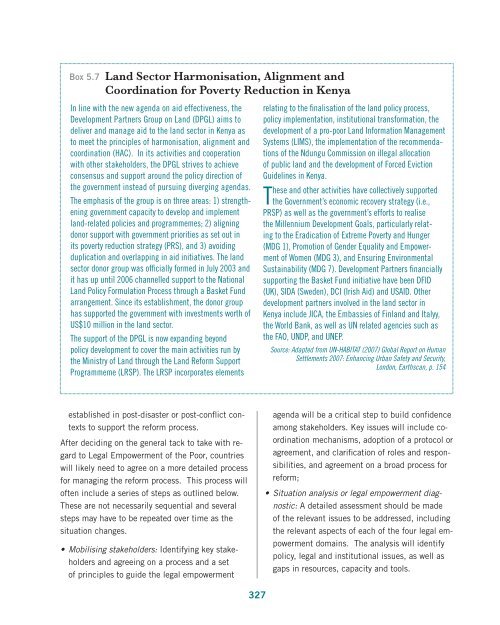Download the file - United Nations Rule of Law
Download the file - United Nations Rule of Law
Download the file - United Nations Rule of Law
Create successful ePaper yourself
Turn your PDF publications into a flip-book with our unique Google optimized e-Paper software.
Box 5.7 Land Sector Harmonisation, Alignment andCoordination for Poverty Reduction in KenyaIn line with <strong>the</strong> new agenda on aid effectiveness, <strong>the</strong>Development Partners Group on Land (DPGL) aims todeliver and manage aid to <strong>the</strong> land sector in Kenya asto meet <strong>the</strong> principles <strong>of</strong> harmonisation, alignment andcoordination (HAC). In its activities and cooperationwith o<strong>the</strong>r stakeholders, <strong>the</strong> DPGL strives to achieveconsensus and support around <strong>the</strong> policy direction <strong>of</strong><strong>the</strong> government instead <strong>of</strong> pursuing diverging agendas.The emphasis <strong>of</strong> <strong>the</strong> group is on three areas: 1) streng<strong>the</strong>ninggovernment capacity to develop and implementland-related policies and programmemes; 2) aligningdonor support with government priorities as set out inits poverty reduction strategy (PRS), and 3) avoidingduplication and overlapping in aid initiatives. The landsector donor group was <strong>of</strong>ficially formed in July 2003 andit has up until 2006 channelled support to <strong>the</strong> NationalLand Policy Formulation Process through a Basket Fundarrangement. Since its establishment, <strong>the</strong> donor grouphas supported <strong>the</strong> government with investments worth <strong>of</strong>US$10 million in <strong>the</strong> land sector.The support <strong>of</strong> <strong>the</strong> DPGL is now expanding beyondpolicy development to cover <strong>the</strong> main activities run by<strong>the</strong> Ministry <strong>of</strong> Land through <strong>the</strong> Land Reform SupportProgrammeme (LRSP). The LRSP incorporates elementsrelating to <strong>the</strong> finalisation <strong>of</strong> <strong>the</strong> land policy process,policy implementation, institutional transformation, <strong>the</strong>development <strong>of</strong> a pro-poor Land Information ManagementSystems (LIMS), <strong>the</strong> implementation <strong>of</strong> <strong>the</strong> recommendations<strong>of</strong> <strong>the</strong> Ndungu Commission on illegal allocation<strong>of</strong> public land and <strong>the</strong> development <strong>of</strong> Forced EvictionGuidelines in Kenya.These and o<strong>the</strong>r activities have collectively supported<strong>the</strong> Government’s economic recovery strategy (i.e.,PRSP) as well as <strong>the</strong> government’s efforts to realise<strong>the</strong> Millennium Development Goals, particularly relatingto <strong>the</strong> Eradication <strong>of</strong> Extreme Poverty and Hunger(MDG 1), Promotion <strong>of</strong> Gender Equality and Empowerment<strong>of</strong> Women (MDG 3), and Ensuring EnvironmentalSustainability (MDG 7). Development Partners financiallysupporting <strong>the</strong> Basket Fund initiative have been DFID(UK), SIDA (Sweden), DCI (Irish Aid) and USAID. O<strong>the</strong>rdevelopment partners involved in <strong>the</strong> land sector inKenya include JICA, <strong>the</strong> Embassies <strong>of</strong> Finland and Italyy,<strong>the</strong> World Bank, as well as UN related agencies such as<strong>the</strong> FAO, UNDP, and UNEP.Source: Adapted from UN-HABITAT (2007) Global Report on HumanSettlements 2007: Enhancing Urban Safety and Security,London, Earthscan, p. 154established in post-disaster or post-conflict contextsto support <strong>the</strong> reform process.After deciding on <strong>the</strong> general tack to take with regardto Legal Empowerment <strong>of</strong> <strong>the</strong> Poor, countrieswill likely need to agree on a more detailed processfor managing <strong>the</strong> reform process. This process will<strong>of</strong>ten include a series <strong>of</strong> steps as outlined below.These are not necessarily sequential and severalsteps may have to be repeated over time as <strong>the</strong>situation changes.• Mobilising stakeholders: Identifying key stakeholdersand agreeing on a process and a set<strong>of</strong> principles to guide <strong>the</strong> legal empowermentagenda will be a critical step to build confidenceamong stakeholders. Key issues will include coordinationmechanisms, adoption <strong>of</strong> a protocol oragreement, and clarification <strong>of</strong> roles and responsibilities,and agreement on a broad process forreform;• Situation analysis or legal empowerment diagnostic:A detailed assessment should be made<strong>of</strong> <strong>the</strong> relevant issues to be addressed, including<strong>the</strong> relevant aspects <strong>of</strong> each <strong>of</strong> <strong>the</strong> four legal empowermentdomains. The analysis will identifypolicy, legal and institutional issues, as well asgaps in resources, capacity and tools.327
















